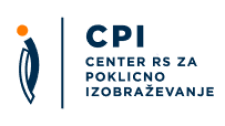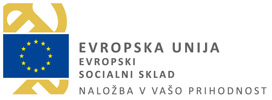Snovalec vizualnih komunikacij in trženja/snovalka vizualnih komunikacij in trženja
Selected qualifications
| Name of qualification | Name of qualification: Snovalec vizualnih komunikacij in trženja/snovalka vizualnih komunikacij in trženjaAdd to comparison |
|---|---|
| Translated title (no legal status) | Translated title: Visual communication and marketing designer |
| Type of qualification | Type of qualification: Short cycle higher vocational diploma |
| Category of qualification | Category of qualification: Educational Qualification |
| Type of education | Type of education: Short cycle higher vocational education |
| Duration |
Duration of education:
2 years
|
| Credits | Credits: 120 credits |
| Admission requirements |
Entry conditions:
Enrolment in a higher education programme is open to anyone who:
|
| ISCED field |
Field:
Arts and humanities
|
| ISCED subfield | subfield: fashion, interior and industrial design |
| Qualification level |
SQF Level:
SQF 6 |
Students will be able to:
(Generic competences:)
- plan, prepare, implement and oversee their own work and the work of others;
- develop entrepreneurial characteristics, skills and behaviour;
- carry out a self-assessment of work;
- communicate with co-workers and experts and advise users;
- use technical terminology and communicate in one foreign language;
- use modern information and communication technologies (ICT);
- lead and/or participate in an expert team and in the resolution of problems;
- manage operations and administrative processes, maintain documentation;
- supervise the work of an expert team and organise work for the field of visual communications and marketing;
- document, order and store materials and ensure the maintenance of tools and equipment;
- plan the organisation of internal education and training, and participate in the education and training of staff;
- ensure the quality of work processes in the visual communications and marketing sector;
- keep abreast of the development of the profession and draft technical proposals for the introduction of new developments in the visual communications and marketing sector;
- ensure the rational use of energy, material and time;
- protect health and the environment and take responsibility for their own safety and the safety of others.
(Vocationally specific competences:)
- ensure the professionalism and quality of interpersonal and business communication, demonstrate mastery of quality communication strategies, including at the inter-cultural level, with a positive attitude to diversity, and understand and accept people from different cultural backgrounds;
- use information and communication technologies (ICT) to search for references and literature, to autonomously process data, and to create and design a corporate identity and presentations in a foreign language;
- systematically approach the collection, organisation and storage of data and information and process and analyse data using simple statistical methods and basic methods of financial operations;
- keep abreast of trends in the visual communications and marketing and design sectors and take them into account;
- use special elements of visual communication and marketing and coordinate activities among different providers;
- manage the work process, monitor and control work in an expert team and the organisation of work;
- participate in an expert team in the planning, design, presentation and marketing of new services, products and programmes;
- demonstrate familiarity with historical artistic styles and movements and incorporate them appropriately into the concept of their own work;
- use light sources, light effects and lighting, form, colour and other formal elements in the promotion of a company and sales promotion;
- plan and organise events, promotions and meetings;
- obtain and use presentation resources and materials that are environmentally friendly and economical;
- plan, coordinate and implement the projects of customers and providers;
- creatively develop and implement visual design concepts that express the philosophy of the business or customer;
- plan and design sales, presentation and exhibition spaces;
- demonstrate mastery of the principles of resolving customer dissatisfaction and complaints;
- implement methods for raising awareness of and monitoring user behaviour patterns;
- advise users on the creation of a corporate identity (for various occasions);
- train users in the correct use of patterns of behaviour in business and private communication and public appearances.
Students' knowledge is assessed by means of practical exercises and seminar papers, and also via products, projects, performances, services, etc. and by examinations. Examination performance is graded as follows: 10 (excellent); 9 (very good: above-average knowledge but with some mistakes); 8 (very good: solid results); 7 (good); 6 (adequate: knowledge satisfies minimum criteria); 5–1 (inadequate). In order to pass an examination, a candidate must achieve a grade between adequate (6) and excellent (10).
Students may progress to the second year if they have successfully completed first-year modules, subjects and practical training (including practical classes, seminar papers, projects, examinations, etc.) totalling at least 45 credits, where all practical classes and practical training course units must be completed in full.
Snovalec vizualnih komunikacij in trženja/snovalka vizualnih komunikacij in trženja
SQF 6
EQF 5
The Career path tab shows the possible career path within the selected qualification area, which is not the only one and is not mandatory. The actual transition between qualifications, which is determined by law, is defined in the Transition tab.
SQF 7 / EQF 6
First-cycle study programmes (SQF, level 7)
A diploma is granted to students who complete all the course units listed below.
1. All compulsory modules and subjects for a total of 80 credits:
- Communications (20 credits),
- Economics and business (20 credits),
- Visual arts (20 credits),
- Projects in the retail space (20 credits) and
2. One of the following elective modules, consisting of 25 credits:
- Decoration (25 credits) or
- Market communication (25 credits).
3. One of the following elective subjects, consisting of 5 credits:
- Consumer behaviour and customer relations (5 credits),
- Interior (5 credits),
- Exterior (5 credits),
- Commercial photography (5 credits) or
- Creative thinking in marketing (5 credits).
4. Freely elective subject (5 credits)
5. Diploma thesis (5 credits)
Higher vocational colleges
URL
Awarding body URL:Upcoming event
International Conference: 10 years of Slovenian Qualifications Framework
International Conference: 10 years of Slovenian Qualifications Framework Brdo Congress Centre, Predoslje 39, 4000...
© Center RS za poklicno izobraževanje, 2018. All rights reserved
Sitemap General legal notice Cookie Policy Production: ENKI






